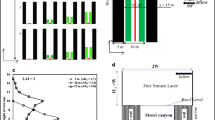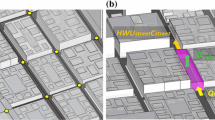Abstract
Despite their importance for pollutant dispersion in urban areas, the special features of dispersion at street intersections are rarely taken into account by operational air quality models. Several previous studies have demonstrated the complex flow patterns that occur at street intersections, even with simple geometry. This study presents results from wind-tunnel experiments on a reduced scale model of a complex but realistic urban intersection, located in central London. Tracer concentration measurements were used to derive three-dimensional maps of the concentration field within the intersection. In combination with a previous study (Carpentieri et al., Boundary-Layer Meteorol 133:277–296, 2009) where the velocity field was measured in the same model, a methodology for the calculation of the mean tracer flux balance at the intersection was developed and applied. The calculation highlighted several limitations of current state-of-the-art canyon dispersion models, arising mainly from the complex geometry of the intersection. Despite its limitations, the proposed methodology could be further developed in order to derive, assess and implement street intersection dispersion models for complex urban areas.
Similar content being viewed by others
References
Arnold SJ, ApSimon H, Barlow J, Belcher S, Bell M, Boddy JW, Britter R, Cheng H, Clark R, Colvile RN, Dimitroulopoulou S, Dobre A, Greally B, Kaur S, Knights A, Lawton T, Makepeace A, Martin D, Neophytou M, Neville S, Nieuwenhuijsen M, Nickless G, Price C, Robins A, Shallcross D, Simmonds P, Smalley RJ, Tate J, Tomlin AS, Wang H, Walsh P (2004) Introduction to the DAPPLE air pollution project. Sci Total Environ 332: 139–153
Belcher SE (2005) Mixing and transport in urban areas. Phil Trans Roy Soc A 363: 2947–2968
Berkowicz R, Hertel O, Larsen SE, Sørensen NN, Nielsen M (1997) Modelling traffic pollution in streets. Danish Ministry of Environment and Energy, National Environmental Research Institute, Denmark
Britter RE, Hanna SR (2003) Flow and dispersion in urban areas. Annu Rev Fluid Mech 35: 469–496
Carpentieri M, Robins AG, Baldi S (2009) Three-dimensional map** of air flow at an urban canyon intersection. Boundary-Layer Meteorol 133: 277–296
Fenger J (1999) Urban air quality. Atmos Environ 33: 4877–4900
Hamlyn D, Hilderman T, Britter RE (2007) A simple network approach to modelling dispersion among large groups of obstacles. Atmos Environ 28: 5848–5862
Hoydysh WG, Dabberdt WF (1994) Concentration fields at urban intersections: fluid modeling studies. Atmos Environ 28: 1849–1860
Kastner-Klein P, Plate EJ, Fedorovich E (1997) Gaseous pollutant dispersion around urban canopy elements: wind tunnel case studies. Int J Environ Pollut 8: 727–737
Ketzel M, Louka P, Sahm P, Guilloteau E, Sini J-F, Moussiopoulos N (2002) Intercomparison of numerical urban dispersion models—Part II: street canyon in Hannover, Germany. Water Air Soil Pollut Focus 2: 603–613
Papathanassiou A, Douros I, Moussiopoulos N (2008) A simplified three-dimensional approach to street canyon modelling using SEP-SCAM. Environ Modell Softw 23: 304–313
Robins A, Savory E, Scaperdas A, Grigoriadis D (2002) Spatial variability and source-receptor relations at a street intersection. Water Air Soil Pollut Focus 2: 381–393
Scaperdas A-S (2000) Modelling flow and pollutant dispersion at urban canyon intersections. PhD thesis, Imperial College of Science, Technology and Medicine, University of London
Scaperdas A, Colvile RN (1999) Assessing the representativeness of monitoring data from an urban intersection site in central London, UK. Atmos Environ 33: 661–674
Soulhac L (2000) Modélisation de la dispersion atmosphérique á l’intérieur de la canopée urbaine. PhD thesis, École Centrale de Lyon, France
Soulhac L, Perkins RP, Salizzoni P (2008) Flow in a street canyon for any external wind direction. Boundary-Layer Meteorol 126: 365–388
Soulhac L, Garbero V, Salizzoni P, Mejean P, Perkins RP (2009) Flow and dispersion in street intersections. Atmos Environ. doi:10.1016/j.atmosenv.2009.02.061
Vardoulakis S, Fisher BEA, Pericleous K, Gonzalez-Flesca N (2003) Modelling air quality in street canyons: a review. Atmos Environ 37: 155–182
Wichmann-Fiebig M, Pfeffer H-U, Rau M (1997) A dataset for the validation of flow and dispersion models as an urban intersection. Int J Environ Pollut 8: 747–760
Wood CR, Arnold SJ, Balogun AA, Barlow JF, Belcher S, Britter RE, Cheng H, Dobre A, Lingard JJN, Martin D, Neophytou MK, Petersson FK, Robins AG, Shallcross DE, Smalley RJ, Tate JE, Tomlin AS, White IR (2009) Dispersion experiments in Central London: the 2007 DAPPLE project. Bull Am Meteorol Soc 90: 955–969
Yamartino RJ, Wiegand G (1986) Development and evaluation of simple models for the flow, turbulence and pollutant concentration fields within an urban street canyon. Atmos Environ 20: 2137–2156
Author information
Authors and Affiliations
Corresponding author
Rights and permissions
About this article
Cite this article
Carpentieri, M., Robins, A.G. Tracer Flux Balance at an Urban Canyon Intersection. Boundary-Layer Meteorol 135, 229–242 (2010). https://doi.org/10.1007/s10546-010-9471-6
Received:
Accepted:
Published:
Issue Date:
DOI: https://doi.org/10.1007/s10546-010-9471-6




